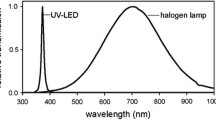Summary
The rhabdomeres of the visual cells in the blowflyCalliphora erythrocephala and the fruit flyDrosophila melanogaster are twisted along their long axes.
In rhabdomeres of the visual cells R1–6 it is possible to distinguish 3 regions differing in twist rate. In the proximal and distal regions the twist is slight (e.g., 0.52°/μm) or absent, whereas in the middle the twist rate is high (e.g., 2.40°/μm). The twisting of the rhabdomeres of R1–3 is congruent and codirectional, and that of R4–6 is its mirror image. The significance of twisting with regard to the dichroic absorption of the microvilli and to the polarization sensitivity and the self-screening of R1–6 is discussed. In particular, it is shown that the dichroic absorption of a single microvillus of R1–6 must be greater than 2; it follows that the absorbing dipoles of the visual pigment molecules must be more or less parallel to the axes of the microvilli. Finally, it can be shown that the twisting of the rhabdomeres R1–6 prevents self-screening — despite high microvillar absorption. Because the microvilli are not uniformly oriented, the twisted rhabdomeres R1–6 are especially effective in absorbing unpolarized light.
Similar content being viewed by others
References
Autrum, H., Stumpf, H.: Das Bienenauge als Analysator für polarisiertes Licht. Z. Naturforsch.5b, 116–122 (1950)
Autrum, H., Zwehl, V. von: Die Sehzellen der Insekten als Analysatoren für polarisiertes Licht. Z. Vergl. Physiol.46, 1–7 (1962)
Boschek, C.B.: On the fine structure of the peripheral retina and lamina ganglionaris of the fly,Musca domestica. Z. Zellforsch.118, 369–409 (1971)
Braitenberg, V.: Ordnung und Orientierung der Elemente im Sehsystem der Fliege. Kybernetik7, 235–242 (1970)
Burkhardt, D., Wendler, L.: Ein direkter Beweis für die Fähigkeit einzelner Sehzellen des Insektenauges, die Schwingungsrichtung polarisierten Lichtes zu analysieren. Z. Vergl. Physiol.43, 687–692 (1960)
Frisch, K. von: Die Polarisation des Himmelslichtes als orientierender Faktor bei den Tänzen der Bienen. Experientia5, 142–148 (1949)
Gemperlein, R., Smola, U.: Die Wirkung linear polarisierten Lichtes auf die Sehzellen vonCalliphora erythrocephala. J. Comp. Physiol.87, 285–292 (1973)
Goldsmith, T.H.: The polarization sensitivity-dichroic absorption paradox in arthropod photoreceptors. In: Photoreceptor optics. Snyder, A.W., Menzel, R. (eds.), pp. 392–409. Berlin, Heidelberg, New York: Springer 1975
Goldsmith, T.H., Wehner, R.: Restrictions on rotational and translational diffusion of pigment in the membranes of a rhabdomeric photoreceptor. J. Gen. Physiol.70, 453–490 (1977)
Gribakin, F.G., Govardovskii, V.I.: The role of the photoreceptor membrane in photoreceptor optics. In: Photoreceptor optics. Snyder, A.W., Menzel, R. (eds.), pp. 215–236. Berlin, Heidelberg, New York: Springer 1975
Grundler, O.J.: Elektronenmikroskopische Untersuchungen am Auge der Honigbiene (Apis mellifera). I. Untersuchungen zur Morphologie und Anordnung der neun Retinulazellen in Ommatidien verschiedener Augenbereiche und zur Perzeption linear polarisierten Lichtes. Cytobiol.9, 203–220 (1974)
Järvilehto, M., Moring, J.: Polarization sensitivity of individual retinula cells and neurons of the flyCalliphora. J. Comp. Physiol.91, 387–397 (1974)
Kirschfeld, K.: Absorption properties of photopigments in single rods, cones and rhabdomeres. In: Processing of optical data by organisms and machines. Reichardt, W. (ed.), pp. 116–136. New York: Academic Press 1969
Kirschfeld, K., Snyder, A.W.: Waveguide mode effects, birefringence and dichroism in fly photoreceptors. In: Photoreceptor optics. Snyder, A.W., Menzel, R. (eds.), pp. 56–77. Berlin, Heidelberg, New York: Springer 1975
Langer, H.: Nachweis dichroitischer Absorption des Sehfarbstoffes in den Rhabdomeren des Insektenauges. Z. Vergl. Physiol.51, 258–263 (1965)
Langer, H.: Grundlagen der Wahrnehmung von Wellenlänge und Schwingungsebene des Lichtes. Verh. Dtsch. Zool. Ges. Göttingen30, 195–233 (1967)
Laughlin, S.B., Menzel, R., Snyder, A.W.: Membranes, dichroism and receptor sensitivity. In: Photoreceptor optics. Snyder, A.W., Menzel, R. (eds.), pp. 237–259. Berlin, Heidelberg, New York: Springer 1975
McCann, G.D., Arnett, D.W.: Spectral and polarization sensitivity of the dipteran visual system. J. Gen. Physiol.59, 534–558 (1972)
McIntyre, P., Snyder, A.W.: Light propagation in twisted anisotrop media: Application to photoreceptors. J. Opt. Soc. Am.68, 149–157 (1978)
Melamed, J., Trujillo-Cenôz, O.: The fine structure of the central cells in the ommatidia of dipterans. J. Ultrastruct. Res.21, 313–334 (1968)
Menzel, R., Blakers, M.: Functional organisation of an insect ommatidium with fused rhabdom. Cytobiol.11, 279–298 (1975)
Moody, M.F., Parriss, J.R.: The discrimination of polarized light byOctopus: a behavioural and morphological study. Z. Vergl. Physiol.44, 268–291 (1961)
Ninomiya, N., Tominaga, Y., Kuwabara, M.: The fine structure of the compound eye of a damsel-fly. Z. Zellforsch.98, 17–32 (1969)
Smola, U.: Das Twisten der Rhabdomere der Sehzellen im Auge vonCalliphora erythrocephala. Verh. Dtsch. Zool. Ges.1977, 234 (1977)
Smola, U., Meffert, P.: A single-peaked UV-receptor in the eye ofCalliphora erythrocephala. J. Comp. Physiol.103, 353–357 (1975)
Snyder, A.W.: Optical properties of invertebrate photoreceptors. In: The compound eye and vision of insects. Horridge, G.A. (ed.), pp. 179–235. Oxford: University Press 1973a
Snyder, A.W.: Polarization sensitivity of individual retinula cells. J. Comp. Physiol.83, 331–360 (1973b)
Snyder, A.W., McIntyre, P.: Polarization sensitivity of twisted fused rhabdoms. In: Photoreceptor optics. Snyder, A.W., Menzel, R. (eds.), pp. 388–391. Berlin, Heidelberg, New York: Springer 1975
Stockhammer, K.: Die Orientierung nach der Schwingungsrichtung des linear polarisierten Lichtes bei Insekten. Z. Vergl. Physiol.38, 30–83 (1956)
Stockhammer, K.: Die Orientierung nach der Schwingunsrichtung linear polarisierten Lichtes und ihre sinnesphysiologischen Grundlagen. Ergebn. Biol.21, 23–56 (1959)
Waterman, T.B.: The optics of polarization sensitivity. In: Photoreceptor optics. Snyder, A.W., Menzel, R. (eds.), pp. 339–371. Berlin, Heidelberg, New York: Springer 1975
Wehner, R., Bernard, G.D., Geiger, E.: Twisted and non-twisted rhabdoms and their significance for polarization detection in the bee. J. Comp. Physiol.104, 225–245 (1975)
Author information
Authors and Affiliations
Additional information
This work was supported by a grant from the Deutsche Forschungsgemeinschaft (Sm 16/3)
Rights and permissions
About this article
Cite this article
Smola, U., Tscharntke, H. Twisted rhabdomeres in the dipteran eye. J. Comp. Physiol. 133, 291–297 (1979). https://doi.org/10.1007/BF00661131
Accepted:
Issue Date:
DOI: https://doi.org/10.1007/BF00661131




